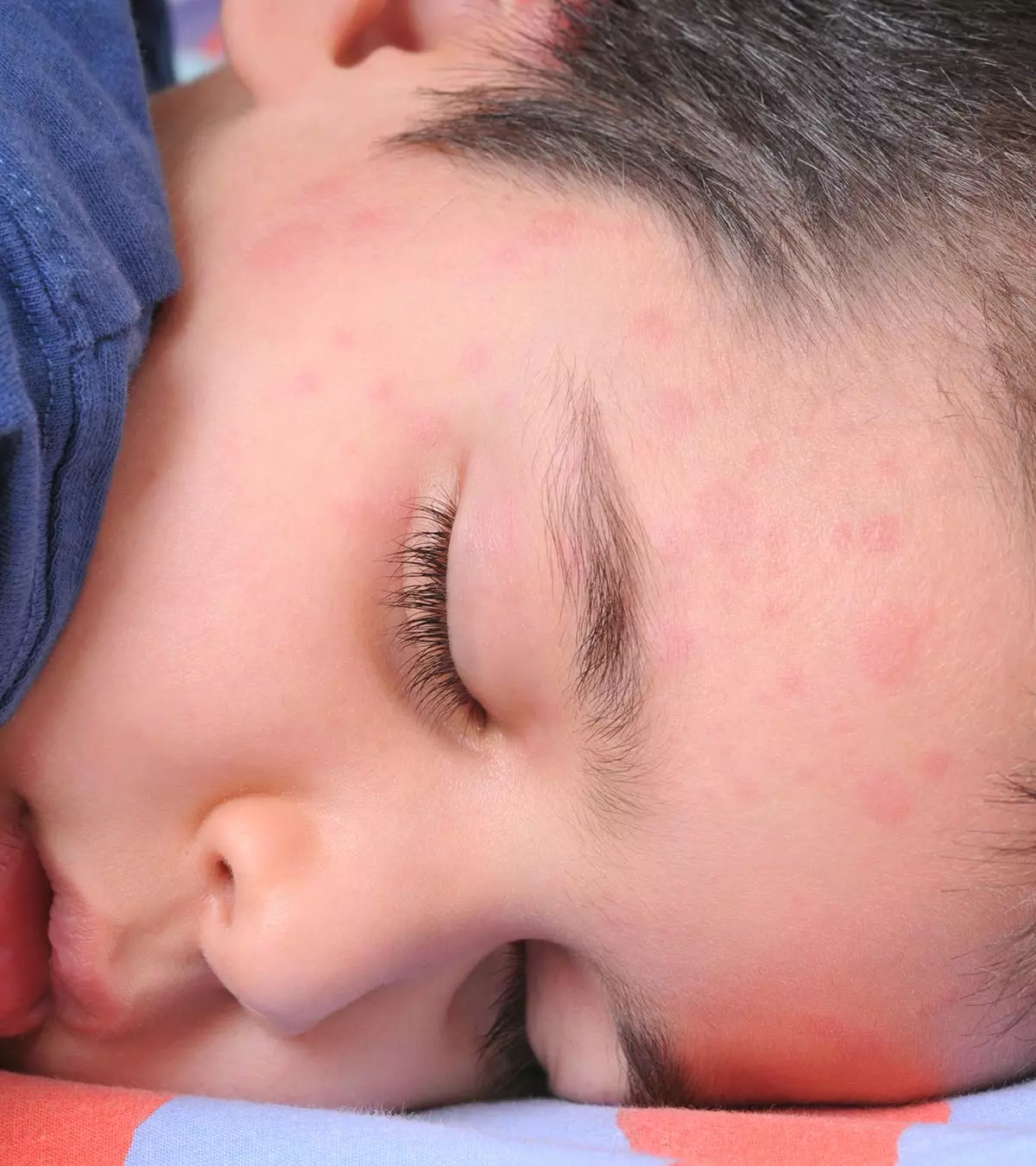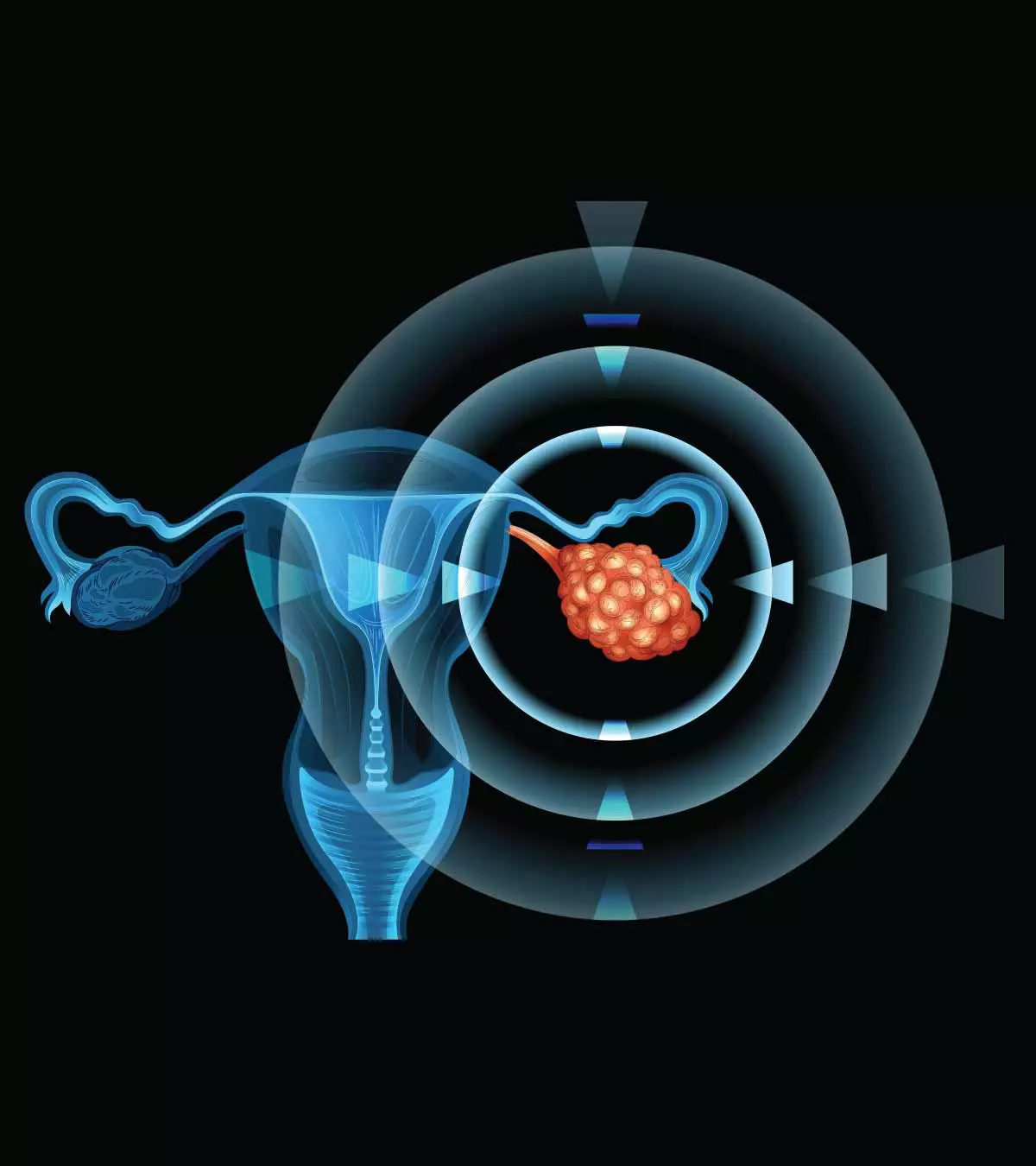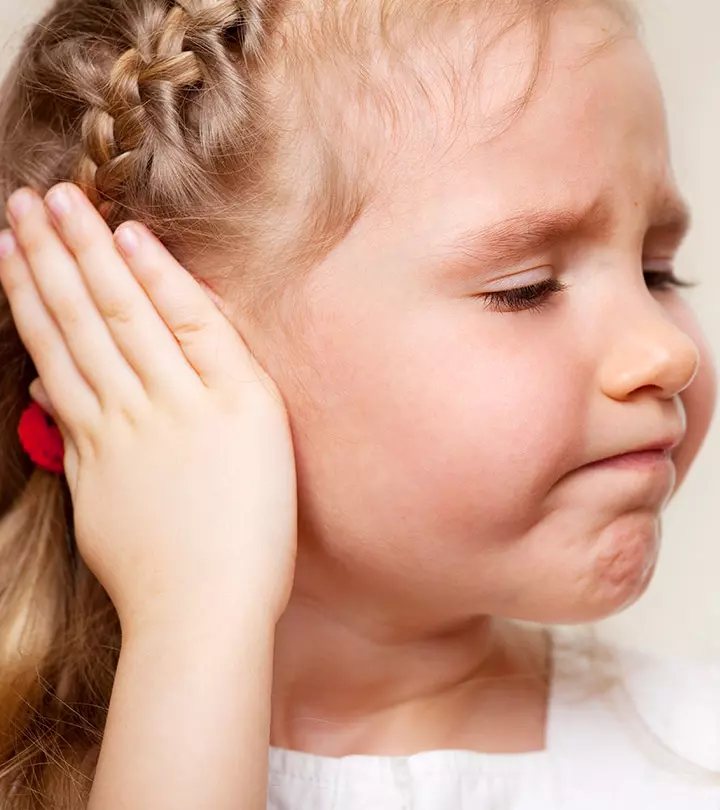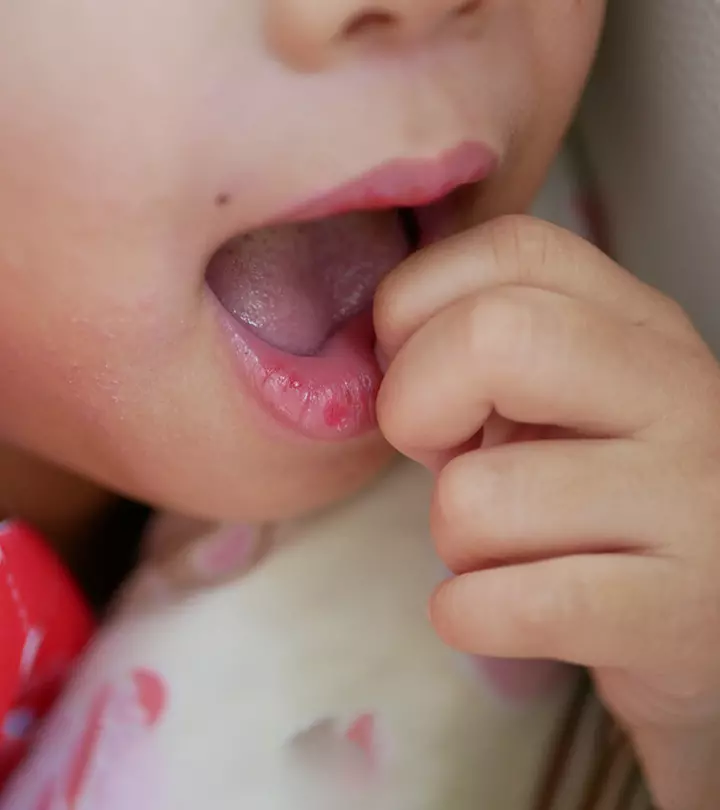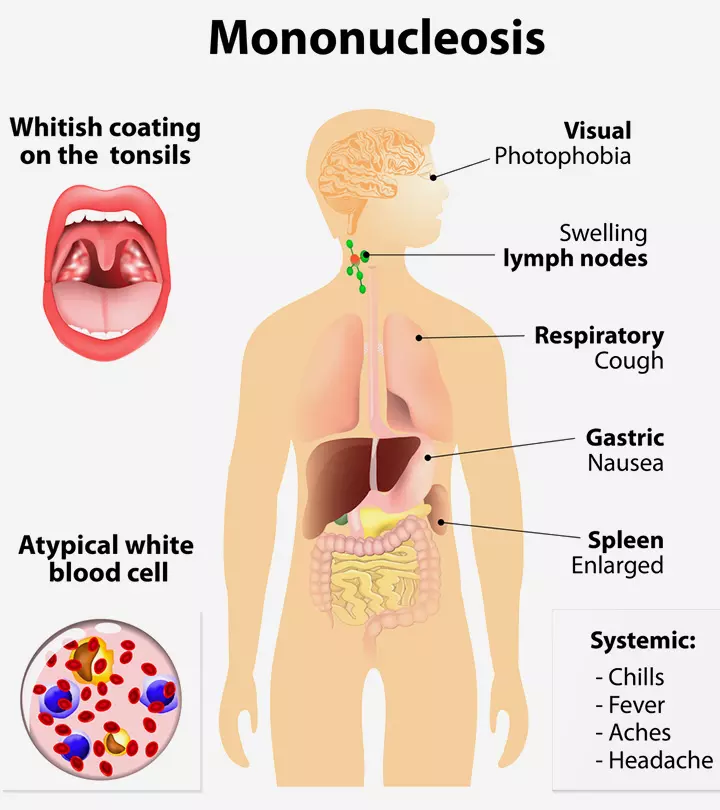
Image: ShutterStock
Nausea can be defined as a queasiness in the stomach that is accompanied by an involuntary urge to vomit. Episodes of nausea in children and adolescents are not uncommon (1) (2). Nausea is not a disease but a complex symptom of various underlying conditions and can be managed at home for some children. Read this post to know more about the causes, home remedies, prevention, diagnosis, and treatment of nausea in children.

Key Pointers
- Nausea in children is caused by various conditions and has associated symptoms.
- Symptoms include fever, abdominal pain, vomiting, headache, dizziness, loss of appetite, and sore throat.
- Home remedies include adequate fluid intake, light, and bland foods, avoiding certain foods, rest, and roasted cumin seeds.
- Encourage slower and smaller meals, high-fiber foods, limit physical activity, and face windscreen if motion sickness arises.
- Common causes are food poisoning, indigestion, stress, constipation, and medication side effects.
Associated Symptoms In Children

There are other symptoms that often accompany nausea. Below are some of the common symptoms of nausea in children (3) (4).
- Fever
- Abdominal pain
- Vomiting
- Dizziness
- Headache
- Loss of appetite
- Sore throat
Home Remedies For Managing Nausea In Children
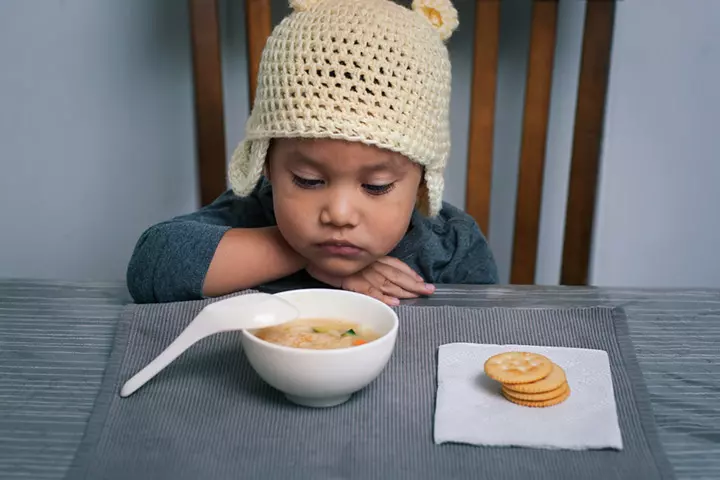
You may try the following tips at home to control your child’s nausea (5).
- Adequate intake of fluids or cold liquids to help ease nausea
- Give them light and bland food (plain bread or a cracker) with a soft texture
- Avoid greasy, fried, sugary, or fatty foods
- Take rest after each meal
- People also use roasted/ grounded cumin seeds. You may simply ask your child to chew them or boil them in water and make them drink it.
 Quick tip
Quick tipIf you suspect nausea to be a side effect of medication, then consult a doctor before stopping the use of the medicine. It is also advisable to take a medical opinion before trying any home remedies to ensure their safety and appropriateness in children.
How To Prevent Nausea In Children?
You may encourage your child to follow these preventive measures (5).
- Eat smaller meals throughout the day instead of a few bigger meals. Teach your child to eat slowly and chew their food properly.
- You may include high-fiber foods (whole grains and fruits with their skin) that are good for the digestive system and can also help prevent constipation.
- Avoid any physical activity after a meal. Also, avoid brushing or cleaning the tongue immediately after the meal since it might induce nausea.
- In the case of motion sickness, you may make your child sit in the car facing the windshield. You can also avoid routes that induce motion sickness. Make them smell a lemon or chew some citrus food to get some relief.
What Causes Nausea In Children?
Nausea in children can be triggered by a range of medical conditions, dietary issues, and emotional factors. Board-certified diplomate of the Philippine Pediatric Society, Dr. Maria Carmela Villania-Mamauag, says, “Nausea may be secondary to a lot of conditions, usually infections, illnesses, food aversion, or motion sickness. It’s particularly concerning in children, as nausea is often one of the first symptoms they report when they’re feeling unwell.”
The following are the most common reasons for nausea in children and teens.
- Food poisoning: Bacteria, viruses, or parasites can enter the gastrointestinal tract through contaminated food and water. These infectious agents release toxins, which can cause food poisoning. A few examples of pathogens are salmonella, shigella, E. coli, and noroviruses. Common symptoms include nausea, vomiting, diarrhea, abdominal cramps, and fever (6). According to a report by the Centers for Disease Control and Prevention (CDC), foodborne diseases affect many individuals in the United States annually. It is estimated that approximately one in six Americans, equivalent to 48 million people, fall ill due to these diseases (31).
- Gastroenteritis: It is an inflammation of the intestinal lining caused by pathogens. Viral gastroenteritis (stomach flu) in children is a common type of gastroenteritis caused by noroviruses. Studies done using the Patient Cohort Explorer at the University of Mississippi Medical Center indicated a 72.73 percent prevalence of viral-pathogen-induced gastroenteritis among the pediatric population (28). Symptoms can include nausea, diarrhea, abdominal pain, stomach discomfort, vomiting, headache, fever, and chills (7).
- Constipation: Constipation could sometimes cause nausea. For instance, a genetic ailment called hirschsprung disease causes chronic constipation due to the inability of the intestines to pass stool. A collateral effect of constipation is the development of nausea (8).
- Indigestion (overeating): Eating too much or too quickly might lead to indigestion in children. It can cause upset stomach, stomach discomfort, nausea (with or without vomiting), burping, heartburn, or bloating (9).
- Stress: Emotional distress (anxiety, depression, or mental stress) can cause functional nausea (when no underlying condition has been identified) among children and adolescents. Other symptoms may include functional abdominal pain, pale skin (pallor), or fatigue (2).
- Reaction to certain foods, smells, or situations: Certain foods or strong smells can cause nausea or vomiting. Moreover, intolerance to certain food items such as dairy-based products (lactose intolerance) can cause nausea, bloating, or abdominal pain in children. Motion sickness also leads to nausea.
- Exposure to chemicals or toxins: Toxic substances or products that are used in day-to-day life, such as fuel oil, alcohol, certain cosmetics, pesticides, and house-cleaning products, can cause mild to serious toxicity in children. Researchers assessed data obtained from the National Fatality Review-Case Reporting System and found that over two-fifths (42.1%, 308 of 731) of poisoning-related fatalities occurred among infants aged (32) (10).
- Medications: Drug-induced nausea is one of the most common side effects of medicines. Nausea and vomiting may also be induced due to chemotherapyiA course of treatment that uses powerful chemicals to kill fast-growing cells in the body, most often cancerous tissue or anestheticsiA drug that induces insensitivity to pain and is often used during surgery given before surgery (11). Pediatrician Dr. Raashid Hamid says, “Beyond antibiotics, use of drugs like chemotherapy agents, antidepressants, or long-term NSAID can trigger severe nausea. Pharmacogenetic testing may identify children prone to adverse reactions, allowing for personalized medication plans.”
- Peptic ulcers: These sores or open wounds occur in the stomach or upper part of the small intestine. They are often caused by infection from Helicobacter pylori bacteria and are characterized by nausea, sudden sharp abdominal pain, burping, hiccups, loss of appetite, and weight loss (12).
- Kidney stones: Kidney stones are a hard solid mass of minerals and elements formed within the kidney. Some of the common symptoms of the condition are severe pain in the back or the sides, nausea, and vomiting (13).
- Gallbladder disease: This condition occurs due to blockage of the bile duct, often as a result of gallstonesiHardened deposits of bile salts in the gallbladder due to excessive cholesterol or bilirubin. . Early signs can include abdominal pain, nausea, or vomiting, especially after eating a meal (14).
- Gastroesophageal reflux disease (GERD): This condition occurs when the contents of the stomach come back (acid reflux) and irritate the food pipe or esophagus. Common symptoms may include nausea, heartburn, bad breath, and vomiting (15).
- Urinary tract infection: Urinary tract infections are more common among females than males. Symptoms can include nausea, vomiting, abdominal, or back pain, fever and chills, and pain or burning during urination (16).

- Irritable bowel syndrome (IBS): This chronic problem affects the large intestine or colon. In IBS, the colon appears normal but does not function properly, leading to symptoms such as abdominal pain, nauseous feeling, abdominal cramping, bloating, and mucus in the stool (17).
- Viral hepatitis: Viral hepatitis is an inflammation of the liver and is associated with the consumption of contaminated food and water. Early symptoms could include fever, fatigue, headache, nausea, vomiting, and abdominal pain (18).
- Concussion: It is a mild traumatic injury to the brain because of a fall or a blow to the head. A few symptoms of concussion include headache, nausea, blurred vision, dizziness, and trouble walking (19).
- Migraine: Primary headache or migraine is under diagnosed in children and adolescents. Along with headaches, the symptoms of migraines may include nausea, sensitivity to light, fatigue, and loss of appetite (20).
- Appendicitis: It is a condition in which the appendix of the child gets blocked and infected. Though a strong and sharp pain is one of the most common symptoms of appendicitis, there are other symptoms accompanying the pain such as nausea, low-grade fever, diarrhea, and vomiting (29).
- Heat exhaustion: Also known as heat illness, this condition occurs when the child is out in the sun for a long time without the intake of adequate fluids, thus causing the body’s cooling system to break down. The symptoms of heat exhaustion include excessive thirst, weakness, muscle cramps (heat cramps), nausea, headache, and profuse sweating. Dizziness in children is, however, one of the most common symptoms of heat exhaustion (30).
 Be watchful
Be watchfulWhen To Call A Doctor?
Seek prompt medical help if your child experiences the following symptoms with nausea or vomiting (4) (5).
- Severe abdominal pain
- Severe headache or stiff neck
- Confusion
- Reduced alertness
- Faster pulse or breathing
- JaundiceiA medical condition arising from excessive bilirubin in the body that causes the yellowing of skin or eyes
- Fever for more than a day
- Symptoms of dehydration

- Low urine output
- Blood in urine or stools or vomitus
 Point to consider
Point to considerDiagnosing The Cause Of Nausea In Children
Doctors do not specifically investigate nausea but the underlying condition or disease that led to nausea in children. The following steps and procedures are used for diagnosis (3).
- Physical examination of the abdomen or torso
- Examining the medical history of the child
- Blood, stool, and urine tests to detect pathogens
- CT scan or MRI (magnetic resonance imaging) of brain or abdomen depending on signs
- Colonoscopy to detect abnormalities in the large intestine and rectum
- Autonomic testing to observe the autonomic nervous system after brain trauma
- Ultrasound of the abdomen
- Upper GI endoscopy to look the insides of the esophagus, stomach, and upper part of the small intestine
- X-rays to check gastrointestinal distress such as the presence of inflammation or intestinal blockage
Quiara Smith, MOT, an expert pediatric pelvic health occupational therapist from West Fargo, North Dakota, says, “The root cause (food allergies, GI issues, anxiety, etc.) of nausea and vomiting is the most important aspect to uncover for the long-term outlook in children, since this affects a child’s functioning across all environments and impacts tasks they need to participate in.”
Treatment Of Nausea In Children

Treatment options depend on the diagnosis of the condition. The doctor might use one or more of the following treatment options (5) (21).
- Antimicrobials for the treatment of infectious diseases
- Anti-inflammatory medicines
- Antacids, H2 blockers, or proton-pump inhibitors for acid reflux
- Dietary changes in the case of IBS or food intolerance
- AntiemeticiA drug used to prevent or suppress vomiting and nausea medications for motion sickness
- Medicines that control the flow of food through the stomach called prokinetics
- Medications for controlling nausea and vomiting in children after chemotherapyiA type of cancer treatment that uses drugs and chemicals to eliminate cancer cells.
- Behavioral therapy, antidepressants, or counseling sessions to relieve nausea due to distress
Smith adds, “After treatment, children continue to utilize coping strategies around nausea and vomiting prevention with the tools they have learned while participating in complementary and alternative medicine intervention.”
Parents are advised not to self-medicate children for nausea and vomiting but you may try some home remedies for mild and infrequent nausea.
Frequently Asked Questions
1. Is nausea without vomiting normal in children?
Yes, nausea may or may not be accompanied by vomiting in children. Depending on what caused it, nausea may occur with other symptoms, such as malaise and diarrhea (24).
2. Can I give children anti-nausea medicine?
Children may be given anti-nausea medicine only after consulting with a doctor to know the proper dosage and administration (25) (26).
3. What over-the-counter medicine is good for nausea in children?
Most over-the-counter medicines (OTC) generally do not require prescriptions. However, OTC anti-nausea medicines such as Dimenhydrinate must be administered only after ensuring their safety and efficacy to avoid cross-interaction with any other medication the child may be taking (27).
Nausea is a frequent complaint among children that usually goes away without treatment. However, in some cases, it could be caused by a serious underlying illness, such as food poisoning, peptic ulcers, or other conditions that require urgent diagnosis and treatment. So, if your child is experiencing severe nausea and vomiting, along with symptoms including jaundice, fever, abdominal pain, headache, and stiff neck, see a doctor right away. Taking the necessary measures and maintaining a healthy diet might also help prevent nausea.
Infographic: Motion Sickness-Induced Nausea In Children
Nausea is an uncomfortable feeling and more so during a fun trip. If your child is one of them, you may want to know more about it and how to make them comfortable through it with the help of this infographic.
Some thing wrong with infographic shortcode. please verify shortcode syntax
Illustration: Causes Of Nausea In Children Treatment And Home Remedies

Image: Dall·E/MomJunction Design Team
Is your child vomiting and showing symptoms similar to diarrhea? Worry not, check out this video where an expert shares how to help your child through this. Explore support methods during these challenging times in this video.
References
1. Kovacic K. and Di Lorenzo C., Functional nausea in children; Journal of Pediatric Gastroenterology and Nutrition (2016)
2. Russell A. C., Stone A. L., and Walker L. S., Functional Nausea in Children: A Review of the Literature and Need for Diagnostic Criteria: Children (Basel, Switzerland)
3. What is nausea and vomiting?; Children’s Wisconsin
4. Vomiting or nausea in children; Harvard Health Publishing
5. Nausea and Vomiting: Care and Treatment; Cleveland Clinic
6. Symptoms of Food Poisoning; CDC
7. Gastroenteritis; U.S. National Library of Medicine
8. Hirschsprung Disease; National Organization for Rare Disorders
9. Indigestion (Dyspepsia); American Academy of Family Physician
10. What You Know Can Help You – An Introduction to Toxic Substances; Department of Health, New York State
11. Maceira E., Lesar T. S., and Smith H. Medication related nausea and vomiting in palliative medicine; Ann Palliat Med
12. Peptic ulcer; U.S. National Library of Medicine
13. Kidney Stones in Children and Teens; American Academy of Pediatrics
14. Gallbladder disease, Wake Forest Baptist Health
15. Symptoms and causes of GER and GERD; NIH NIDDK
16. Moreno M. A., Urinary Tract Infections in Children and Adolescents; JAMA Pediatrics (2016).
17. Irritable Bowel Syndrome (IBS) in Children; Stanford Children’s Health
18. Viral Hepatitis; A.T. Still University/Kirksville College of Osteopathic Medicine
19. Signs and Symptoms of Concussion; CDC
20. Kabbouche M.A., and Gilman, D.K., Management of migraine in adolescents; Neuropsychiatric Disease and Treatment (2008)
21. Keller V. E., Management of nausea and vomiting in children; Journal of Pediatric Nursing
22. Treating Vomiting; American Academy of Pediatrics
23. Vomiting in children and babies; NHS
24. Nausea; Johns Hopkins Medicine
25. Treating Vomiting; Healthy Children
26. ONDANSETRON (ZOFRAN); Children’s Minnesota
27. Paul Enarson et al.(2011); Dimenhydrinate use for children with vomiting; NCBI
29. Appendicitis In Kids and Teens; The Nemours Foundation
30. Heat Exposure and Reactions; Children’s Hospital Colorado
31. Burden of Foodborne Illness; Findings; CDC
32. Christopher E. Gaw et al.; Characteristics of Fatal Poisonings Among Infants and Young Children in the United States; American Academy of Pediatrics (2025)
Community Experiences
Join the conversation and become a part of our nurturing community! Share your stories, experiences, and insights to connect with fellow parents.
Read full bio of Dr. Anuradha Bansal
- Dr. Raashid Hamid is a consultant in the department of Pediatric Surgery at GMC hospital and associate professor of Pediatric and Neonatal Surgery at SKIMS, Jammu & Kashmir, India. He has four years of experience and specializes in general surgeries, including appendectomy, cholecystectomy, and exploratory laparotomy.
 Dr. Raashid Hamid is a consultant in the department of Pediatric Surgery at GMC hospital and associate professor of Pediatric and Neonatal Surgery at SKIMS, Jammu & Kashmir, India. He has four years of experience and specializes in general surgeries, including appendectomy, cholecystectomy, and exploratory laparotomy.
Dr. Raashid Hamid is a consultant in the department of Pediatric Surgery at GMC hospital and associate professor of Pediatric and Neonatal Surgery at SKIMS, Jammu & Kashmir, India. He has four years of experience and specializes in general surgeries, including appendectomy, cholecystectomy, and exploratory laparotomy. - Dr. Maria Carmela Villania-Mamauag is a board certified diplomate of the Philippine Pediatric Society with a degree of Doctor of Medicine from Our Lady of Fatima University, Valenzuela City and a Bachelor in Science in Psychology from Saint Louis University, Baguio City which was augmented by a year of Bachelor in Science in Family Life and Child development at the University of the Philippines, Diliman, Quezon City.
 Dr. Maria Carmela Villania-Mamauag is a board certified diplomate of the Philippine Pediatric Society with a degree of Doctor of Medicine from Our Lady of Fatima University, Valenzuela City and a Bachelor in Science in Psychology from Saint Louis University, Baguio City which was augmented by a year of Bachelor in Science in Family Life and Child development at the University of the Philippines, Diliman, Quezon City.
Dr. Maria Carmela Villania-Mamauag is a board certified diplomate of the Philippine Pediatric Society with a degree of Doctor of Medicine from Our Lady of Fatima University, Valenzuela City and a Bachelor in Science in Psychology from Saint Louis University, Baguio City which was augmented by a year of Bachelor in Science in Family Life and Child development at the University of the Philippines, Diliman, Quezon City. - Quiara C. Smith is an expert pediatric pelvic health occupational therapist (OT) and owner of a private boutique pediatric pelvic health practice in California and Hawaii. She has been a pediatric therapist for over 13 years, working in the NICU and other settings. Quiara did her masters in OT from Samuel Merritt University and is pursuing her doctorate at Elizabethtown College.
 Quiara C. Smith is an expert pediatric pelvic health occupational therapist (OT) and owner of a private boutique pediatric pelvic health practice in California and Hawaii. She has been a pediatric therapist for over 13 years, working in the NICU and other settings. Quiara did her masters in OT from Samuel Merritt University and is pursuing her doctorate at Elizabethtown College.
Quiara C. Smith is an expert pediatric pelvic health occupational therapist (OT) and owner of a private boutique pediatric pelvic health practice in California and Hawaii. She has been a pediatric therapist for over 13 years, working in the NICU and other settings. Quiara did her masters in OT from Samuel Merritt University and is pursuing her doctorate at Elizabethtown College.
Read full bio of Dr. Ritika Shah
Read full bio of Swati Patwal
Read full bio of Ghazia Shah










